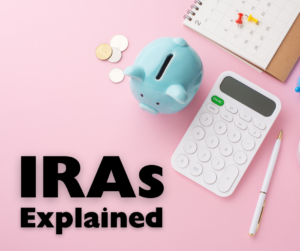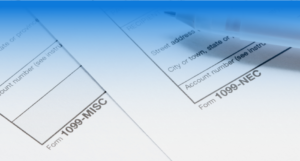As the summer days begin to shorten and grocery store displays are replaced with colorful rows of pens, highlighters, and binders, it is obvious that the school season is nearing. While many find a satisfying thrill and buzzing energy that comes with the new possibilities of fresh bright yellow pencils, clean stacks of paper, and empty folders with flashy designs, for others, there can be a dreadful feeling as the price of these school supply essentials add up with every scanning “beep” of the register.
For those dreading the rising prices of school supplies, there may be some good news. Educators, students, and donors alike, may be able to get some of their money back on their taxes for the year, simply by following a few good record keeping practices.
Educators

Many teachers go above and beyond for their students, often using money out of their own pockets to supply their classrooms with materials. Thus, it makes sense that eligible educators can find some of the largest deductions on school supplies when tax season rolls around. Educators can receive up to a $300 deduction for unreimbursed qualifying expenses. If a couple filing jointly are both educators, this deduction can be as much as $600.
According to the IRS, “an eligible educator is a kindergarten through twelfth grade teacher, instructor, counselor, principal, or aide [who worked] in a school for at least 900 hours during a school year.”1
Qualifying expenses are defined by the IRS as: “ordinary and necessary expenses paid in connection with books, supplies, equipment, and other materials used in the classroom.”2 To be considered “ordinary and necessary”, an expense must be common in the field or subject that is being taught, and the item purchased is helpful or required for the successful completion of the lesson or teaching in general. It is also important to remember that qualifying expenses are those that are not reimbursed by the department, school, or district in any way.3 Take a look below at some examples of qualifying expenses.
School Supplies
Most general school supplies are covered as qualifying expenses, such as:
- Pens, pencils, and highlighters
- Paper
- Notebooks
- Sticky notes
- Coloring Materials (markers, colored pencils, etc.)
- Whiteboard markers, chalk, erasers
- Easel paper and anchor charts
- Cleaning wipes
- Etc.
Equipment
Necessary equipment can include items such as:
- Computer equipment or software (computer, chargers, printer ink, etc.)
- Books, etc. (for English or classroom libraries)
- Rulers, protractors, counting blocks, etc. (for Math)
- Balls, cones, poly spots, frisbees, etc. (for Heath and P.E.)
- Science experiment supplies (for science units)
Professional Development
Depending on the school district policy, another qualifying expense may be professional development expenses. To qualify, the professional development must:
- Not be reimbursed or compensated for by the school
- Required for the educator (to meet either school or certification requirements)
- Be related to the subject or curriculum that the educator teaches
Non-Qualifying Educator Expenses
These items do not qualify as educator expenses and cannot be used towards the tax credit:
- Personal Items for classrooms (extra hygiene items, microwave, etc.)
- Lunches
- Equipment that is not athletic equipment for Health or Physical Education classes
- Homeschooling supplies
Teachers should also be aware that they may have to reduce their qualified expenses total when filing taxes by the following amounts:
- Excludable U.S. series EE and I savings bond interest (on Form 8815)
- Nontaxable qualified state tuition program earnings
- Nontaxable earnings from Coverdell education savings accounts
- Any additional reimbursements received for teaching expenses that were not reported on form W-2, box 1.4
College Students and Parents

For college students, or parents of college students who pay for school expenses and claim the student as a dependent on their taxes, there may also be credits and deductions available for school supplies purchased throughout the year.
There are various credits that allow qualified education expenses to be applied to the credit or deduction. Qualified education expenses for college students typically include the amounts paid for tuition, general fees (like activity fees or technology fees that are charged to all enrolled students to pay for on-campus organizations, materials, or activities), and course supplies.5 So, what about those aisles of school supplies and back to school promotional deals? As long as the expense is for a specific course or supplies for college classes in general, it is a qualifying education expense. Living expenses outside of the education program, however, do not qualify for a deduction or credit.6
Take a look below to see some examples of what does and does not qualify as an education expense for college students.
Examples of Qualifying Expenses
- Pens, Pencils, Highlighters
- Paper or Notebooks
- Sticky Notes
- Binders, Folders, Organizers
- Planner
- Backpack
- Laptop Computer
- Textbooks or Required Reading Books
- Required Equipment for a course like safety goggles, lab coat, etc.
Examples of Non-Qualifying Expenses
- New bedding, mattress topper, etc.
- Mini fridge, microwave, water kettle, coffee maker, etc.
- Shower caddy, towels, personal hygiene supplies, etc.
- Laundry bags, detergents, dryer sheets, or money for machines
- Rent or room and board expenses
- Medical expenses
- Insurance
- Bike, car, gas, bus fares, ride shares, or any other transportation
- Meals, snacks, or food
- Sports equipment or fees
When it comes to purchasing course supplies, what funds are being used to buy them matters for deduction qualification. School supplies can be paid for with cash, check, credit or debit card, or money from a loan and qualify for a deduction or credit. However, if they are paid for with tax-free funds, such as tax-free grants, scholarships, or fellowships, then those items will no longer be eligible to qualify for deductions or credits.7 Where school supplies are bought, does not matter as much as what kind of funds they are purchased with. Supplies can be purchased from on campus book or supply stores, grocery stores, or even ordered online.
Donors
Many people donate to schools, especially at the start of the year. For instance, parents might donate supplies to their child’s school, friends of teachers may donate items to the classroom, or good samaritans might donate supplies to community fundraisers or donation bins around town. Anyone donating school supplies this year may be able find tax deductions available for such donations. Before rushing to the store and filling up a cart with school supplies, there are some things to consider to make sure that a donation will be tax deductible come April.
First and foremost, make sure that donations for school supplies are going to a qualified organization.8 Click below to see more about examples of qualified organizations:
Public School District Programs and Schools
If a school district program or individual school program is not operating for profit and is solely supported by state and local government funding, then donations can go directly to a school or school district.9 This can be especially helpful for parents or families that want to donate directly to their child’s school or school district.
Colleges or Universities
Donations to a university will qualify for a charitable donations deduction, as long as they have 501(c)(3), or non-profit, status and the donor is receiving no incentives in return. Most universities will usually let donors designate what they would like the funds to go to, which means if there is a specific group or program a donor would like to support, they can earmark these funds for that specific purpose at the time of donation.
Corporations or Foundations
There are many corporations and foundations that help support students and teachers in need. Again, double check that whatever organization the donation is made to has a non-profit status or 501(c)(3) designation.
Community and Religious Drives
A community drive or fund to help get school supplies to kids and educators can also be a qualifying organization. Similarly, a religious organization in the community that puts on a fundraiser for students in need could be a qualifying organization. Double check that these drives and funds are not for profit, that they help to support educational purposes, and that those organizing the drive can provide a receipt for your donation.

Donors should also be aware of what they are donating and requirements around determining the cost of items donated. Donating money is usually the most straightforward method of donation, since the value of what is being donated is clear. The amount of money donated is usually the same amount that is eligible for charitable donations deductions.10 However, sometimes drives are for school supplies directly, where donors purchase items for the drive. In this case, donors should make sure to retain the receipts that show the fair market value of the goods purchased for the drive, as it is the fair market value of the goods that are eligible for deductions. If donating used goods, donors may want to get written, professional appraisals of the items donated, if they plan to claim the deduction on their taxes.11
However donors choose to donate, make sure that the organization donated to provides a receipt of the donation. Donors who donated $250 or more are required to obtain a donation receipt.12 However, even if a donor donates less than this amount, it is always a good idea to request one for personal records, especially if planning to claim a charitable donation deduction on taxes. This receipt should include the name of the organization, the amount of a cash contribution, a description of non-cash contributions, and a statement that no goods or services were received in return.13
A Note to Teachers: While teacher social media campaigns are all the rage, when asking for school supply donations from the community, it may be best to partner with a 501(c)(3) or qualified charitable organization. Working with such an organization gives donors the incentive of a tax deduction option. It also means that the organization takes on the liability of recording and reporting the donations to the IRS so that individual teachers are not liable for reporting the gifts on their personal taxes.
Record Keeping Tips
Whether a teacher, student, parent, or donor buying school supplies, if anyone is planning to put these purchases towards a tax credit or deduction, it is important that purchases and donations are well documented. Clear documentation of receipts helps make sure that deductions are calculated correctly and are seen as legitimate should the IRS choose to review or audit the tax return. Here are some helpful tips to follow when purchasing school supplies this year.
Make Clear Transactions
When purchasing supplies, make sure that qualifying items are purchased separately from any non-qualifying items. Make sure receipts reflect only the qualifying items. If needed, ask a cashier to create two separate transactions.
Example 1: A college student goes to Target to pick up supplies for the start of Freshman year. While there, they pick out a notebook, pens, and a new comforter for their dorm room. When checking out, they have the cashier ring up the notebook and the pens on one transaction, and then purchase the comforter on a separate transaction. Since the notebook and pens are qualifying items, these goods are on one receipt that is saved for taxes, separate from the non-qualifying comforter.
Example 2: A teacher is ordering expo markers, a large post-its easel pad, and new shirt for work on Amazon. When placing the order, the teacher moves the shirt from the cart to the “saved for later” list, so that the qualifying items (expo markers and easel pad) can be purchased separately on an order that is saved for taxes. Once the qualifying items are ordered, the teacher moves the shirt back to the chart and purchases it in a separate personal order.
Save Receipts in Safe Place

There is nothing worse than misplacing the receipts needed to correctly add and document expenses for a tax credit or deduction. Be sure to have a consistent place where these records are kept, and as soon as a new receipt is acquired, add it to this place as soon as possible. One option is to create a good old-fashioned folder and put the receipts in the folder as they accumulate. Another option is to upload pdf versions and pictures of receipts to a folder on a computer and keep them digitally until tax season.
Save Receipts for Three Years
Once the credit or deduction is applied to a tax return, be sure to save the receipts with the tax return for at least three years from the date of filing. The period of limitations in which someone can amend a tax return is three years, given that it was accurate and filed.14 Be sure to keep a copy and any supporting documentation (like receipts) for credits or deductions taken for at least three years, in case any amendments need to be made.
By saving receipts and being aware of what school supplies qualify for credits or deductions, teachers, students, and donors alike can enjoy the thrill of picking out their favorite flair pens, planners, or notebooks. Taking the extra steps to make sure that necessary school supply purchases help out next tax season is a smart way to start the school year.
For more information about this topic or to get help with taxes, please contact us at Nottingham and Associates, CPA’s.
- U.S. Department of the Treasury. Internal Revenue Service. (2020). Publication 529: Miscellaneous Deductions. Retrieved from https://www.irs.gov/pub/irs-pdf/p529.pdf. ↩︎
- U.S. Department of the Treasury. Internal Revenue Service. (2020). Publication 529: Miscellaneous Deductions. Retrieved from https://www.irs.gov/pub/irs-pdf/p529.pdf. ↩︎
- Internal Revenue Service. (2024, Feb 09). Topic no. 458, Educator expense dedication. https://www.irs.gov/taxtopics/tc458. ↩︎
- U.S. Department of the Treasury. Internal Revenue Service. (2020). Publication 529: Miscellaneous Deductions. Retrieved from https://www.irs.gov/pub/irs-pdf/p529.pdf. ↩︎
- Internal Revenue Service. (2023, Oct 05). Qualified Education Expenses. https://www.irs.gov/credits-deductions/individuals/qualified-ed-expenses. ↩︎
- Internal Revenue Service. (2023, Oct 05). Qualified Education Expenses. https://www.irs.gov/credits-deductions/individuals/qualified-ed-expenses. ↩︎
- Internal Revenue Service. (2023, Oct 05). Qualified Education Expenses. https://www.irs.gov/credits-deductions/individuals/qualified-ed-expenses. ↩︎
- Internal Revenue Service. (2024, May 29). Charitable Contribution Deductions. https://www.irs.gov/charities-non-profits/charitable-organizations/charitable-contribution-deductions. ↩︎
- Intuit TurboTax. (2024, Jun 6). Are Contributions to School District Programs Tax Deductible? https://turbotax.intuit.com/tax-tips/charitable-contributions/are-contributions-to-school-district-programs-tax-deductible/L6YhGgwPA##. ↩︎
- Internal Revenue Service. (2024, May 29). Charitable Contribution Deductions. https://www.irs.gov/charities-non-profits/charitable-organizations/charitable-contribution-deductions. ↩︎
- U.S. Department of the Treasury. Internal Revenue Service (Rev. 2024, Feb). Publication 561: Determining the Value of Donated Property (Cat. No. 15109Q). Retrieved from https://www.irs.gov/pub/irs-pdf/p561.pdf ↩︎
- Internal Revenue Service. (2024, May 29). Charitable Contribution Deductions. https://www.irs.gov/charities-non-profits/charitable-organizations/charitable-contribution-deductions. ↩︎
- Internal Revenue Service. (2023, Dec 26). Charitable contributions: Written acknowledgements. https://www.irs.gov/charities-non-profits/charitable-organizations/charitable-contributions-written-acknowledgments. ↩︎
- Internal Revenue Service. (2024, Jul 22). How long should I keep records? https://www.irs.gov/businesses/small-businesses-self-employed/how-long-should-i-keep-records. ↩︎




